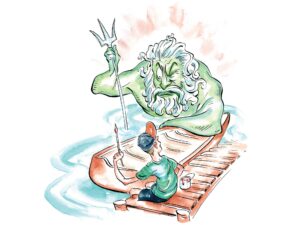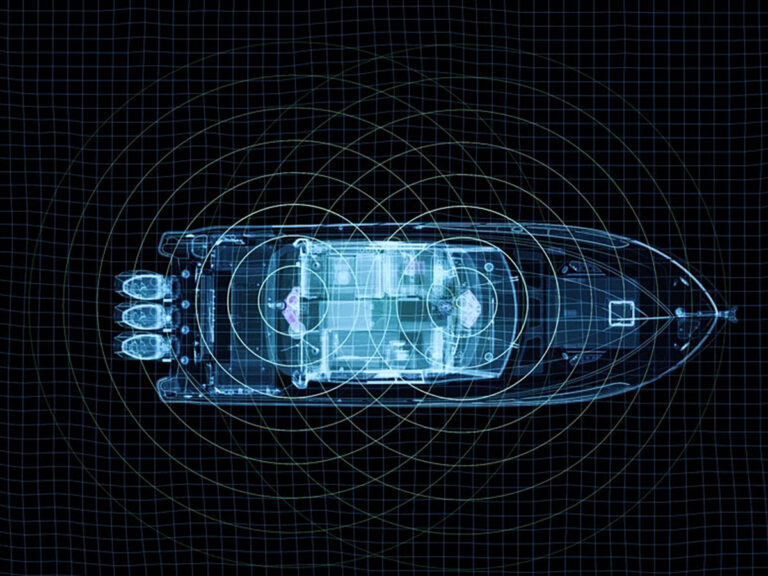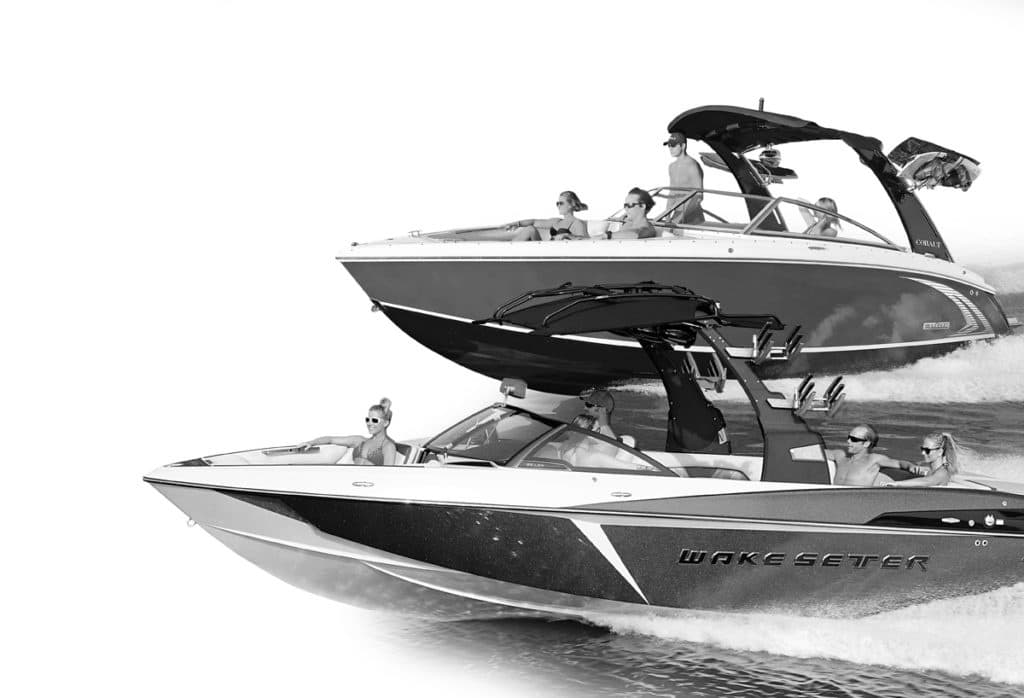
Like its ocean-borne counterpart, wakesurfing is huge fun, but the majority of the population never gets invited. With the real deal, that’s a result of simple geography. To paraphrase the Beach Boys, not everybody has an ocean. With wakesurfing, however, the limiting factor has always been the location of the boat’s propeller. In a sport that places the rider in close proximity to the boat’s transom, the average sterndrive, with its rear-mounted prop, is deemed too risky for wakesurfing. As a result, this genre of wakesports has become a members-only club, with inboard and V-drive owners the only ones to make it beyond the velvet rope.
In 2015, Volvo Penta changed the rules. With an eye on the burgeoning surf crowd, the longtime maker of inboards and sterndrives took a cue from its successful IPS pod drive and put the prop in front of a sterndrive’s lower unit. The aptly named Forward Drive quickly caught the attention of builders of sterndrive-powered boats missing out on the surf craze and opened the doors of wakesurfing to an eager and wider new audience of boaters.
But can a Forward Drive-equipped runabout compare to the gold standard of a V-drive-powered towsports boat? And can a V-drive compare to a sterndrive’s versatility apart from generating surf? To find out, we put together two flagship models from each category, called in a pair of expert surf riders, and put each type of propulsion through its paces.

Vive la Difference
The V-drive was represented by the 25-foot Malibu Wakesetter 25 LSV. Powered by an Indmar 6.2L Monsoon 450 HO engine, it features the classic V-drive layout, with the engine spun 180 degrees and pushed to the rear to maximize cockpit space and, in the case of wakesports, take advantage of weight at the stern. The drive shaft extends forward to a gear box, where it is then redirected aft and out through the hull. Abaft the propeller, a movable rudder influences direction. Our Forward Drive candidate, Cobalt’s 25-foot-8-inch R5 WSS Surf, likewise positions the engine in classic sterndrive fashion under a stern lounge. The drive linkage then exits out through the transom, where it is redirected downward through the outdrive, then forward to the propeller. Like a conventional sterndrive, steering is the result of vectored thrust. The drive and propeller pivot in unison in relation to the driver’s input at the helm. Both systems position the prop well under the hull and out of reach of riders playing in the wake.
Prop location, however, has little to do with building the perfect wake. For both manufacturers, this portion of the equation starts with ballast, plumbed to be easily filled and drained at the touch of a button. Malibu features four rigid tanks built into the hull, spread between the bow and stern and capable of adding 1,475 pounds to the boat’s load. In addition, our test boat also utilized Malibu’s optional Power Wedge II hydrofoil. While most foils offer lifting-only action, this pulls the stern downward, mimicking an additional 1,500 pounds of ballast when lowered, and the plug-and-play ballast can add still another 1,500 pounds of wave-creating weight.
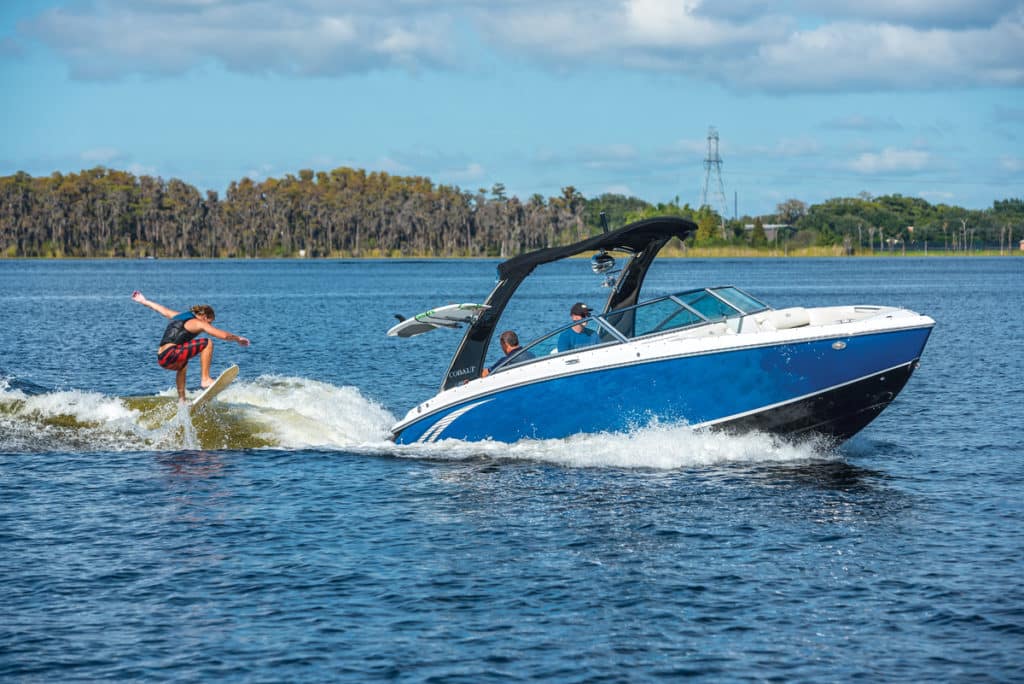
Cobalt features three internal ballast tanks located port, starboard and center capable of adding 2,100 pounds to the boat’s load. The drive can also be trimmed, or it can be raised to effectively force the stern deeper into the water and further enhance wake size.
The true magic, however, happens thanks to each boat’s wake-shaping hardware. Malibu’s Surf Gate system features two vertical, hinged tabs at each corner of the hull adjacent to the swim platform. Extending one of these tabs outward disrupts the convergence point of the water coming off the hull sides, causing the boat to heel over to one side, greatly increasing both the size and shape of the wake.
Like the majority of Forward Drive manufacturers, Cobalt opts for surf tabs: oversize, extended trim tabs that can be pivoted downward on the desired side to likewise enhance wake size and shape. Unlike most of its competitors, Cobalt relies upon a larger tab size and a unique, curved shape.

Surf’s Up
With ballast filled to capacity and a comparable passenger load, we ran numerous passes with the author at the wheel and both professional wakeboarder Jeff House and Wakeboarding magazine’s contributing editor Craig Kotilinek surfing the wake to judge each’s characteristics.
In terms of sheer wave height, Malibu held the advantage, producing a clean wake that ran between 3¼ to 3½ feet on average. That wake felt larger and stronger to both riders, with a steeper face that offered more forward push. The workable area of the wake extended as much as 20 feet behind the transom of the boat and seemed to wrap around the rider in a gentle arc. Even the trailing curl and whitewash offered some degree of forward push.

The Cobalt wake averaged between 2¾ to 3¼ feet in height, with a more ramplike shape that pushed the rider out and away from the wake and featured slightly more turbulence. The workable area of the wake extended to about 15 feet off the transom but fell away rapidly beyond that point. Kotilinek noted that the Cobalt’s pocket was larger than most Forward Drive models but didn’t offer quite as much forward push. He also observed that a Forward Drive’s prop wash can be more disruptive for beginning riders when starting; an easy solution is to have the driver angle slightly away from the rider until they’re on top of the water. Because the Forward Drive features counter-rotating props, prop torque is not an issue.
Driver controls proved simple for both models. Malibu provides complete customization of the wake via touchscreen control of ballast load, Power Wedge angle, Surf Gate and speed. An optional analog control knob is also available. Cobalt opts for physical buttons to fill and empty ballast, set the GPS-based Zero Off cruise control, and deploy tabs to the surfer’s preferred side. Once preset, both systems allow you to simply throttle up; control takes over once you reach the desired speed. As the left or right surf orientation is gate- or tab-based, both allowed drivers to switch the wake’s focus on the fly, transitioning between the left and right sides in roughly three seconds for the Malibu and four for the Cobalt. From the driver’s perspective, while both boats ran bow high at boarding speeds (10 to 12 mph), the Malibu ran at a shallower angle, making it easier to see forward. Cobalt offers a Performance Mode that deploys the tabs to get on plane even with a full ballast load. With the Malibu, you can adjust the angle of the optional Power Wedge for similar results.

Power Struggle
Away from the wakesports with minimal load and no ballast or surf enhancement, each model displayed characteristics inherent to its category. Thanks in part to its ability to trim and reduce the hull’s wetted surface, the Forward Drive-powered Cobalt held a notable advantage in top speed, powering to 46.6 mph despite the Malibu’s additional 20 hp. With a shallower deadrise, downward prop-shaft angle and less underwater hardware to overcome, however, the Malibu jumped onto plane more quickly (4.7 seconds versus 6.2) and posted a superior from-0-to-30 mph time (7.4 seconds versus 10.5). At surf speeds of 11 mph, fuel consumption was comparable for each boat, averaging in the neighborhood of 7 gph. The sterndrive Cobalt burned approximately 9 gph at a 26 mph cruising speed, the V-drive Malibu just over 11.

With its vectored thrust, the Forward Drive held an advantage in low-speed handling, able to be turned nimbly to both port and starboard in reverse. In fact, reverse is superior to a conventional sterndrive, as the props are deep in the water and away from the effects of the exhaust. With no directional thrust and without water passing over the rudder in reverse, the V-drive was subject to prop torque and the rotation of its propeller. It backed predictably to port but lacked the same level of control to starboard.

Other considerations? Forward Drive’s ability to trim is handy in shallow situations, but the forward position of the dual props means a Forward Drive does not trim as high as a conventional sterndrive; it leaves the drive exposed by about a foot below the hull even when fully trimmed. That exposure, as well as the V-drive’s prop, shaft and rudder, mean both boats need to sit higher than outboards, jets or other sterndrives on dedicated trailers to avoid damage when towing. V-drive hardware is fixed; the Forward Drive features both breakaway couplings between vertical shafts and a “kick-up” release to lessen damage from an underwater strike. Both types of propulsion provide exceptional handling at speed, with the Forward Drive surpassing its conventional sterndrive counterpart thanks to the forward position of the prop. The typical Forward Drive hull’s deeper V and ability to trim, however, give it an advantage in rough water. The V-drive is slightly less complex than the Forward Drive. Stainless shafts and Nibral (nickel, bronze and aluminum) props also hold a corrosion advantage over the Forward Drive’s painted aluminum housing and stainless-steel props.
Finally, the Forward Drive proved much quieter at speed. Credit it in part to the drive’s exhaust outlet below the waterline.
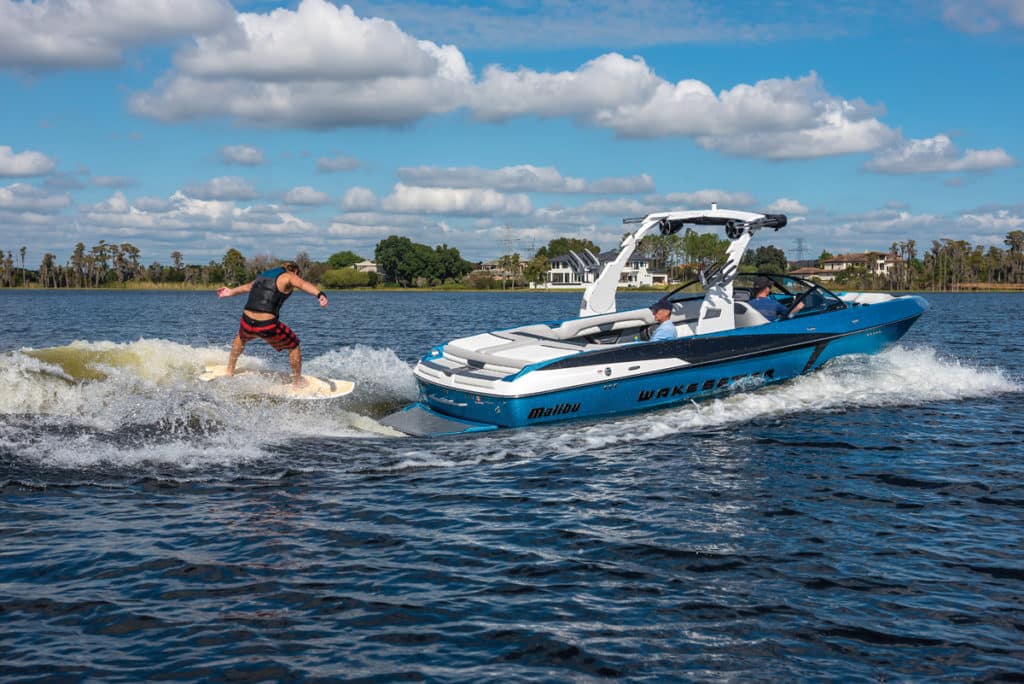
Let’s Go Surfing Now
So who’s the winner? That depends on the buyer and what they want.
In terms of pure wakesurfing nirvana, it’s a V-drive. Wake size, shape and characteristics are simply superior. But by eliminating the safety concerns of an exposed propeller, the Forward Drive has opened up the sport to a much larger audience. The wakes, and the ease of controlling them, are within the ballpark of those produced by a V-drive. The ability to trim, better top speed, and superior low-speed and reverse handling also all favor the Forward Drive.
In short, with the option of both V-drive and Forward Drive propulsion, everybody wins … and everybody surfs.

While V-drive and Forward Drive might currently have more of the spotlight, a third type of propulsion — jet drive — is also making its case for surf supremacy. With only an enclosed impeller tucked within the hull confines, jets certainly boast the necessary safety advantage. Several manufacturers have also gotten into the game of shaping wakes. Chaparral’s 243 Vortex VRX offers 1,350 pounds of ballast along with the Aerial Surf Platform, an extension integrated into the existing swim platform that is contoured below to shape the wake for surfing. Yamaha’s 242X E-Series features 1,400 pounds of ballast in bags tucked inside storage compartments and plumbed to easily fill and empty via dash controls. How’s the jet wake? Definitely surfable, although we have not found it yet up to the standards of either the V-drive or Forward Drive. The wake itself it not as clean, as the jet tends to create more turbulence. The pocket also tends to be smaller. But additional ballast, or just more friends in the boat, improves the wake significantly.



